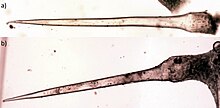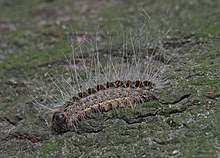Stinging hair
Stinging hairs are hair-like structures that mechanically cause a stinging sensation when touched through tiny barbs and / or by means of special active ingredients . They are best known for nettles , where they sit on the stem and above the leaves on the plant. But there are also stinging hairs in insects, namely the caterpillars of the processionary moth , and tarantulas .
Stinging hairs in plants

Painful wheals arise when touching the stinging hairs of many nettle plants or the flower nettle plants (or from Neesia ) . The stinging hairs have a head that is silicified and has a predetermined breaking point . If the head is torn off when touched, it leaves behind the sharp-edged, rigid hair. This digs into the skin and empties the mixture of serotonin , histamine , acetylcholine , formic acid and sodium formate contained in it . The main active ingredient that is responsible for the formation of wheals is not yet known. A ten-thousandth of a milligram of this fuel liquid is enough to achieve the well-known effect. The base of the hair (base) consists of epidermal cells and hypodermic cells, so it is an emergence , while the actual stinging hair is a single-cell trichome .
See also: Plant defense against herbivores , section “Stinging hairs” in the article stinging nettles
Stinging hairs in animals
The stinging hairs of the arthropods are bristles, part of the cuticle , containing chitin as a structure-determining material.
Stinging hairs in insects
The caterpillars of some butterfly species have stinging hairs that are supposed to protect them from their predators. The species whose caterpillars have stinging hairs include, for example, the oak processionary moth ( Thaumetopoea processionea ), whose stinging hairs break easily and can be spread for kilometers with the wind. They contain the nettle poison Thaumetopoein and have barbs . In humans, these stinging hairs cause allergic skin reactions, eye irritation and if they get into the airways, symptoms such as irritation of the throat and asthmatic attacks can result. In strong caterpillar years - gradation - it may be necessary to close off the affected areas to unprotected people.
The caterpillars of other processionary moth species and some Trägspinnerarten as the gypsy moth ( Lymantria dispar ) and the brown-tail ( Euproctis chrysorrhoea ), are equipped with stinging hairs. Another species of butterfly whose caterpillars have stinging hairs is the oak moth ( Lasiocampa quercus ).
Stinging hairs in spiders
Many tarantula species also have stinging hairs . These usually sit on the spider's abdomen . The stinging hairs cause severe itching on the skin or, depending on the type, even burning rashes. This irritation can last for up to a day. If the hair gets into the airways, it leads to a strong cough and, in allergy sufferers , swelling, which can be dangerous. If the stinging hairs get into the eyes, conjunctivitis can result.
Stinging hairs only have the two subfamilies of tarantulas found in the New World , the Theraphosinae and the Aviculariinae . The hair is 0.3 to 0.75 mm long and has a large number of tiny barbs . The mode of action of the spider's stinging hairs has not yet been precisely researched. Scientists assume, however, that it is a purely mechanical irritation of the skin from the many barbs and not a poisonous effect such as a spider bite or the nettle venom of the stinging hairs of caterpillars of processionary moths.
The so-called bombardier spiders can quickly strip off the many tiny hairs from the top of the abdomen with the help of their hind legs and hurl them at the attacker. A cloud of fine stinging hair then hits the attacker. The giant tarantula ( Theraphosa blondi ) also shows such behavior .
Others of these tarantulas have stinging hairs, but do not bombard them with them, but stretch their abdomen towards an attacker. If touched, these can injure the attacker. This includes many species of the genus Avicularia . Species of the genus Ephebopus have stinging hairs on the femora of their buttons .
Broken stinging hairs are replaced after the next moult. Adult males are an exception.
Web links
- Poisonous animal: Tarantula in general (PDF file; 89 kB)
Individual evidence
- ^ N. Leitz, M. Arnold, Reinhard Leitz: Caterpillar dermatitis caused by oak processionary moths. In: The German Dermatologist. 9, 2003, pp. 684-685.
- ↑ Brennhaare ( memento of July 25, 2013 in the Internet Archive ) by Brachypelma smithi
- ^ SD Marshall, GW Uetz: The pedipalpal brush of Ephebopus sp. (Araneae, Theraphosidae): evidence of a new site for urticating hairs. In: Bulletin of the British Arachnological Society. 8, 4, 1990, pp. 122-124.
- ↑ Burning and bombing at Vogelspinnen.info



